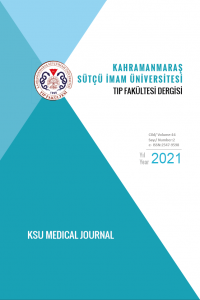Abstract
Amaç: Sezaryen (C/S), tüm dünyada jinekolog tarafından gerçekleştirilen en yaygın ameliyatlardan biridir. Bu çalışmanın amacı, bu özel hasta grubundaki deneyimlerimizi sunmak ve bir C/S prosedürü sonrası mesane flebi olan ve olmayan hastaların erken ve geç sonuçlarını karşılaştırmaktır.
Gereç ve Yöntem: Ekim 2018 ile Ocak 2019 arasında C/S nedeniyle başvuran tüm vakalar hastanenin elektronik tıbbi kayıtlarından alındı. Demografik veriler, perioperatif test sonuçları, operatif özellikler, postoperatif komplikasyonlar ve sonuçlar hakkında veriler toplandı. C/S kararı cerrah tarafından plasenta previa, ablatio plasenta, malpresentasyon, fetal distres, makrozomi ve umbilikal kord sarkmaları gibi fetal veya maternal problemler için verildi. Hastalar, Grup 1'de mesane flebi olan C/S, Grup 2 ise mesane flebi olmayan hastalardan oluşacak şekilde ikiye ayrıldı.
Bulgular: Çalışmaya ortalama yaşları 27.87 ± 4 olan 63 hasta dahil edildi. Her iki gruptaki hastaların hiçbirinde mesane yaralanması yoktu. Grupların karşılaştırılması, grubun maternal yaş, ağırlık, vücut kitle indeksi (VKİ) ve gebelik haftası açısından istatistiksel olarak eşit olduğunu gösterdi. Grup 1 hastalarında mikrohematüri varlığı anlamlı olarak daha yüksekti (p = 0.000, OR 2.55,% 95 CI 1.568-4.159) ve hemoglobin düzeylerinde istatistiksel olarak anlamlı düşüş vardı (Grup 1 0.91 ± 1.48'e karşı Grup 2 0.13 ± 1.24, p = 0.026). Bununla birlikte, hematokrit değerlerindeki azalma istatistiksel olarak anlamlı değildi (Grup 1 1,78 ± 6,84'e karşı Grup 2 0,63 ± 4,09, p = 0,423). Postoperatif rezidüel idrar ise mesane flebi olan hastalarda biraz daha yüksekti.
Sonuç: C / S sırasında mesane flebi kan kaybı, ameliyat süresi ve postoperatif semptomlar üzerinde olumsuz etkilere sahiptir. Bu nedenle, flebin çıkarılması hem hasta hem de cerrah için ameliyat sonrası konforu artıracaktır.
Keywords
References
- Sayın Hocam yayınımın en kısa dönemde geri dönüş yapılmasını rica ediyorum. Saygılarımla
Abstract
Objective: Cesarean section (C/S) is one of the most common operation performed by the gynecologist throughout the world. The aim of this study is to present our experience in this particular group of patients and compare the early and late outcomes of the patients with and without a bladder flap after a C/S procedure.
Materials and Method: All cases admitted between October 2018 and January 2019 due to C/S were retrieved from hospital electronic medical records. Data were collected on demographics, perioperative test results, operative characteristics, postoperative complications and outcomes. The C/S decision was given by the surgeon per fetal or maternal problems such as placenta previa, ablatio placenta, malpresentation, fetal distress, macrosomia and prolapses of the umbilical cord. Patients were grouped into two as Group 1 comprised patients who had C/S with bladder flap while Group 2 included the patients without bladder flap.
Results: There were 63 patients included in the study with a mean age of 27.87 ± 4. None of the patients in either group had bladder injury. The comparison of the groups demonstrated the group were statistically equal in maternal age, weight, body mass index (BMI) and gestational week. The presence of microhematuria was significantly higher in Group 1 patients (p=0.000, OR 2.55, 95% CI 1.568-4.159) and there was statistically significant decrease in the hemoglobin levels (Group 1 0.91 ± 1.48 vs Group 2 0.13 ± 1.24, p=0.026). However, the decrease in the hematocrit values did not statistical significance (Group 1 1.78 ± 6.84 vs Group 2 0.63 ± 4.09, p=0.423). The postoperative residual urine, on the other hand, was slightly higher in patients with bladder flap.
Conclusion: Bladder flap during C/S has adverse effects on the blood loss, surgical time and postoperative symptoms. Hence, omitting the flap will improve the postoperative comfort both for the patient and the surgeon.
References
- Sayın Hocam yayınımın en kısa dönemde geri dönüş yapılmasını rica ediyorum. Saygılarımla
Details
| Primary Language | English |
|---|---|
| Subjects | Health Care Administration |
| Journal Section | Araştırma Makaleleri |
| Authors | |
| Publication Date | July 7, 2021 |
| Submission Date | March 28, 2020 |
| Acceptance Date | December 11, 2020 |
| Published in Issue | Year 2021 Volume: 16 Issue: 2 |

